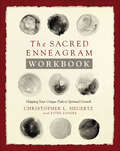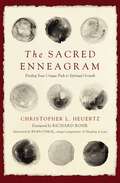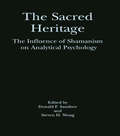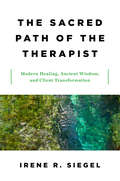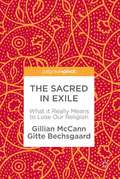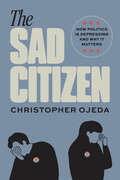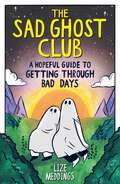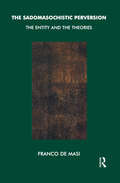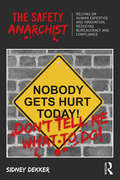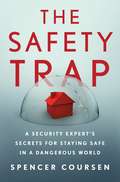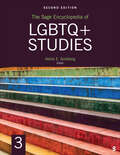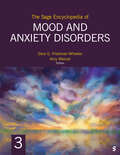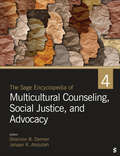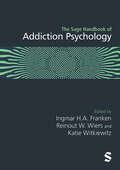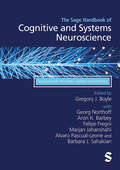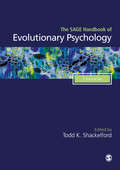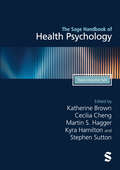- Table View
- List View
The Sacred Enneagram Workbook: Mapping Your Unique Path to Spiritual Growth
by Christopher L. Heuertz Estee ZandeeWhether you are looking to discover your type for the first time or take a deeper dive into your identity, The Sacred Enneagram Workbook is designed to help you grow in your spiritual life through the understanding of your Enneagram type.Most of us spend a lifetime trying to figure out who we are and how we relate to others and God. This task is far from easy, yet the Enneagram offers a bright path to cutting through the internal clutter and finding our way back to who we are created to be. And The Sacred Enneagram Workbook creates the reflective space necessary to map your way home. Join international Enneagram teacher Chris Heuertz in this interactive companion to the bestselling The Sacred Enneagram to discover:Where you find yourself in the Enneagram's nine type profiles, and how to make sense of testing resultsHow to move beyond counterproductive caricatures of your type toward true growthTools and practices for breaking out of your greatest emotional, interpersonal, and spiritual challengesAnd ultimately, your type's unique invitation and path toward a deeper journey with God
The Sacred Enneagram: Finding Your Unique Path to Spiritual Growth
by Richard Rohr Christopher L. HeuertzFor all the ways we live unawakened lives, the enneagram is here to help.The Sacred Enneagram is a trustworthy, richly insightful guide to finding yourself in the enneagram’s 9-type profiles, and applying this practical wisdom for a life transformed. Far more than a personality test, author Chris Heuertz writes, the enneagram is a sacred map to the soul. Lies about who we think we are keep us trapped in loops of self-defeat. But the enneagram offers a bright path to cutting through the internal clutter and finding our way back to God and to our true identity as God created us.Chris Heuertz’ life was forever changed after he learned about the enneagram 15 years ago. Today, he leads enneagram workshops all over the world. Join Chris as he shows you how this ancient tool can help you awaken to the gifts God has given you, find freedom from your personal patterns of sin and fear, and grow in acceptance of your identity as you grow with God.In conversational style with compelling stories, The Sacred Enneagram will show youHow to understand the 'why' behind your type, beyond caricatures and stereotypesHow to align your type with prayer posturesHow to identify and find freedom from self-destructive patternsHow to grow in spiritual discernmentHow to face your past wounds and step toward healingHow to awaken your unique gifts to serve today’s broken worldChris’s own journey with the enneagram is an accessible introduction and exploration of how the enneagram can change your life, because to the extent that we are transformed, the world will be transformed.
The Sacred Heritage: The Influence of Shamanism on Analytical Psychology
by Donald F. Sandner Steven H. WongThe contributors to this volume describe the many facets shamanism and depth psychology have in common: animal symbolism; recognition of the reality of the collective unconscious; and healing rituals that put therapist and patient in touch with transpersonal powers. By reintroducing the core of shamanism in contemporary form, these essays shape a powerful means of healing that combines the direct contact with the inner psyche one finds in shamanism with the self-reflection and critical awareness of modern consciousness. The contributors' draw from experiences both inside and outside the consulting room, and with cultures that include the Lakota Sioux, and those of the Peruvian Andes and the Hawaiian Islands. The focus is on those aspects of shamanism most useful and relevant to the modern practice of depth psychology. These explorations bring the young practice of analytical psychology into perspective as part of a much more ancient heritage of shamanistic healing.
The Sacred Path of the Therapist: Modern Healing, Ancient Wisdom, And Client Transformation
by Irene R. SiegelIntegrating Western psychological understanding with ancient Eastern and wisdom traditions, Siegel addresses how spiritual resonance is achieved within the psychotherapeutic process in The Sacred Path of the Therapist. Readers will learn how mindfulness practices and attunement can help them move clients toward recovery and beyond, allowing full potential to emerge within a shared coherent field of awakening consciousness. Topics include translating transpersonal theory into practice, understanding the human energy field, and the integration of psychotherapy and spiritual initiation. Drawing from her unique experiences working with master shamans as well as practicing as a psychotherapist, Irene Siegel discusses the evolving role of the therapist as both therapist and healer. Shamans are ancestral teachers, guides to nonordinary realms of consciousness and a divine cosmic whole within silent sacred spaces. Using lessons from native shamanic tradition and the evolving field of transpersonal psychology, both healer and client will learn to access the innate inner wisdom and healing potential within themselves through guided meditation exercises within moment-by-moment sacred space. The expanding content and context of therapy blends the two worlds: the clinical world and the world of the shaman.
The Sacred in Exile: What It Really Means To Lose Our Religion
by Gillian Mccann Gitte BechsgaardThis book addresses the fact that, for the first time in history, a large segment of the population in the western world is living without any form of religious belief. While a number of writers have examined the implications of this shift, none have approached the phenomenon from the perspective of religious studies. The authors examine what has been lost from the point of view of sociology, psychology, and philosophy of religion. The book sits at the nexus of a number of important debates including: the role of religion in public life, the connection between religion and physical and psychological well-being, and the implications of the loss of ritual in terms of maintaining communities.
The Sad Citizen: How Politics Is Depressing and Why It Matters
by Christopher OjedaFor many citizens, politics is depressing. How has this come to be the norm? And, how is it influencing democracy? From rising polarization to climate change, today’s politics are leaving many Western democracies in the throes of malaise. While anger, anxiety, and fear are loud emotions that powerfully activate voters, depression is quiet, demobilizing, and less visible as a result. Yet its pervasiveness is cause for concern: after all, democracy should empower citizens. In The Sad Citizen, Christopher Ojeda draws on wide-ranging data from the United States and beyond to explain how politics is depressing, why this matters, and what we can do about it. Integrating insights from political science, sociology, psychology, and other fields, The Sad Citizen exposes the unhappy underbelly of contemporary politics and offers fresh ideas to strengthen democracy and help citizens cope with the stress of politics.
The Sad Ghost Club: A Hopeful Guide to Getting Through Bad Days (The Sad Ghost Club #4)
by Lize MeddingsWelcome to the Sad Ghost Club - a club for anyone who has ever felt sad or lost. We can all feel anxious and alone sometimes. Like you're almost . . . invisible. But at the Sad Ghost Club, you can find your kindred spirits and know you're not alone. In this graphic novel, discover the Sad Ghost Club's rules for taking things one day at a time. With heartwarming and very relatable comic illustrations, discover how to make it through the day, grow through the hard stuff and look out for your fellow ghosties. Based on the Sad Ghost Club community, with over 600k followers on Instagram. This is a place where everyone is accepted and everyone belongs.Join the community of ghosties on Instagram @theofficialsadghostclub
The Sadomasochistic Perversion: The Entity and the Theories
by Franco De MasiThis book examines the terminology used in the analysis of sadomasochism, surveys extensively, and in detail, the theories of other psychoanalysts, and explores the relationship between sadomasochism and depression; its relationship to psychosis, borderline states, and many other conditions.
The Safety Anarchist: Relying on human expertise and innovation, reducing bureaucracy and compliance
by Sidney DekkerWork has never been as safe as it seems today. Safety has also never been as bureaucratized as it is today. Over the past two decades, the number of safety rules and statutes has exploded, and organizations themselves are creating ever more internal compliance requirements. At the same time, progress on safety has slowed to a crawl. Many incident- and injury rates have flatlined. Worse, excellent safety performance on low-consequence events tends to increase the risk of fatalities and disasters. Bureaucracy and compliance now seem less about managing the safety of the workers we are responsible for, and more about managing the liability of the people they work for. We make workers do a lot that does nothing to improve their success locally. Paradoxically, such tightening of safety bureaucracy robs us of exactly the source of human insight, creativity and resilience that can tell us how success is actually created, and where the next accident may well happen. It is time for Safety Anarchists: people who trust people more than process, who rely on horizontally coordinating experiences and innovations, who push back against petty rules and coercive compliance, and who help recover the dignity and expertise of human work.
The Safety Trap: A Security Expert's Secrets for Staying Safe in a Dangerous World
by Spencer CoursenThreat management expert Spencer Coursen offers proactive strategies to protect yourself and your loved ones in the event of hostile encounters and emergency situations in The Safety Trap: A Security Expert’s Secrets for Staying Safe in a Dangerous World.Despite what the news and social media would have you believe, we have never lived in a safer time than we are now. Unfortunately, we live under a false sense of security enforced by authorities that only alleviates fears without reducing risk. We have placed our personal safety, and our responsibilities of guarding it, into the hands of people trained only to respond to crises, not actively prevent them. Our blind faith in institutions to protect us has only dulled our natural survival instincts. The truth is that when we feel safest is actually when we are in the most danger.This is the paradox of The Safety Trap.When you don’t expect danger, you simply fail to see the signs that something bad is about to happen. But the signs are always there, and staying safe is about training yourself to see them. In easy-to-implement methods of maintaining vigilance, assessing risk, and taking preventative measures, you’ll discover how to be alert without anxiety and know how to best protect and defend yourself on the job, in school, in public places, at home, and online.With Coursen’s simple formula of Awareness + Preparation = Safety as your guide—as well as real world examples of managing threats—you will learn how to develop the skills and confidence to reclaim your own security and avoid The Safety Trap.
The Sage Encyclopedia of LGBTQ+ Studies, 2nd Edition
by Abbie E. GoldbergThe SAGE Encyclopedia of LGBTQ Studies, 2nd Edition is aimed at students and educators interested in an interdisciplinary perspective on LGBTQ issues. It examines and provides understandings of the lives and experiences of LGBTQ individuals, with attention to the contexts and forces that shape their world. The volume addresses questions such as: What are the key theories used to understand variations in sexual orientation and gender identity? What does LGBTQ+ affirmative therapy look like? How have anti-LGBTQ ballot measures affected LGBTQ people? What are LGBTQ+ people’s experiences during COVID-19? How were LGBTQ+ people impacted by the Trump administration? What is life like for LGBTQ+ people living outside the United States? This encyclopedia looks at LGBTQ issues and identity primarily through the lenses of psychology, human development, and sociology, while emphasizing queer, feminist, and ecological perspectives on this topic. Entries are written by top researchers and clinicians across multiple fields—psychology, human development, gender/queer studies, sexuality studies, social work, nursing, cultural studies, education, family studies, medicine, public health, and sociology.
The Sage Encyclopedia of LGBTQ+ Studies, 2nd Edition
by Abbie E. GoldbergThe SAGE Encyclopedia of LGBTQ Studies, 2nd Edition is aimed at students and educators interested in an interdisciplinary perspective on LGBTQ issues. It examines and provides understandings of the lives and experiences of LGBTQ individuals, with attention to the contexts and forces that shape their world. The volume addresses questions such as: What are the key theories used to understand variations in sexual orientation and gender identity? What does LGBTQ+ affirmative therapy look like? How have anti-LGBTQ ballot measures affected LGBTQ people? What are LGBTQ+ people’s experiences during COVID-19? How were LGBTQ+ people impacted by the Trump administration? What is life like for LGBTQ+ people living outside the United States? This encyclopedia looks at LGBTQ issues and identity primarily through the lenses of psychology, human development, and sociology, while emphasizing queer, feminist, and ecological perspectives on this topic. Entries are written by top researchers and clinicians across multiple fields—psychology, human development, gender/queer studies, sexuality studies, social work, nursing, cultural studies, education, family studies, medicine, public health, and sociology.
The Sage Encyclopedia of Mood and Anxiety Disorders
by Amy Wenzel Dara Gail Friedman-WheelerCourses in psychological distress and disorders are among the most popular courses in psychology programs, and mood and anxiety disorders are among the most prevalent disorders covered in these classes and encountered by mental health professionals. Although there are books on mood and anxiety disorders, on particular aspects of them, and on their presentation in specific populations, such works do not provide students new to the field with a comprehensive and accessible ready reference for understanding these disorders with respect to their phenomenology, etiology, and treatment, and through an inclusive lens that consistently considers how these symptoms appear and are construed across cultures, addressing societal factors such as race, culture, equity, and oppression. It is hoped that The SAGE Encyclopedia of Mood and Anxiety Disorders will fill this gap, allowing students and other interested readers to become familiar with past and current approaches and theories and to enhance their understanding of the sociocultural factors that affect how we discuss, approach, and treat these types of psychological distress. As such, consideration of sociocultural factors will infuse the three-volume set. The encyclopedia will consist of approximately 450 entries (essays), arranged alphabetically within three volumes.
The Sage Encyclopedia of Mood and Anxiety Disorders
by Amy Wenzel Dara Gail Friedman-WheelerCourses in psychological distress and disorders are among the most popular courses in psychology programs, and mood and anxiety disorders are among the most prevalent disorders covered in these classes and encountered by mental health professionals. Although there are books on mood and anxiety disorders, on particular aspects of them, and on their presentation in specific populations, such works do not provide students new to the field with a comprehensive and accessible ready reference for understanding these disorders with respect to their phenomenology, etiology, and treatment, and through an inclusive lens that consistently considers how these symptoms appear and are construed across cultures, addressing societal factors such as race, culture, equity, and oppression. It is hoped that The SAGE Encyclopedia of Mood and Anxiety Disorders will fill this gap, allowing students and other interested readers to become familiar with past and current approaches and theories and to enhance their understanding of the sociocultural factors that affect how we discuss, approach, and treat these types of psychological distress. As such, consideration of sociocultural factors will infuse the three-volume set. The encyclopedia will consist of approximately 450 entries (essays), arranged alphabetically within three volumes.
The Sage Encyclopedia of Multicultural Counseling, Social Justice, and Advocacy
by Shannon B. Dermer Jahaan R. AbdullahSince the late 1970s, there has been an increase in the study of diversity, inclusion, race, and ethnicity within the field of counseling. The SAGE Encyclopedia of Multicultural Counseling, Social Justice, and Advocacy will comprehensively synthesize a wide range of terms, concepts, ideologies, groups, and organizations through a diverse lens. This encyclopedia will include entries on a wide range of topics relative to multicultural counseling, social justice and advocacy, and the experiences of diverse groups. The encyclopedia will consist of approximately 600 signed entries, arranged alphabetically within four volumes.
The Sage Encyclopedia of Multicultural Counseling, Social Justice, and Advocacy
by Shannon B. Dermer Jahaan R. AbdullahSince the late 1970s, there has been an increase in the study of diversity, inclusion, race, and ethnicity within the field of counseling. The SAGE Encyclopedia of Multicultural Counseling, Social Justice, and Advocacy will comprehensively synthesize a wide range of terms, concepts, ideologies, groups, and organizations through a diverse lens. This encyclopedia will include entries on a wide range of topics relative to multicultural counseling, social justice and advocacy, and the experiences of diverse groups. The encyclopedia will consist of approximately 600 signed entries, arranged alphabetically within four volumes.
The Sage Handbook of Addiction Psychology
by Katie Witkiewitz Reinout W. Wiers Ingmar H.A. FrankenThe Sage Handbook of Addiction Psychology presents a comprehensive overview of the state of the science behind the psychology of addiction, offering a crucial resource for psychologists engaged in both research and practice. The Handbook features a distinguished international group of contributors, all renowned specialists in their respective fields and emphasizes a forward-looking perspective. Chapters delve into psychological theories of addiction and evidence-based addiction treatment, offering practical insights on the intricacies of addiction psychology. The handbook takes a holistic approach by incorporating neighbouring fields traditionally outside of psychology; it explores economics, genetics, public health, neurobiology, computer science, and sociology, recognizing that psychology and individual-centered perspectives are just one facet of addiction. This multifaceted approach ensures that readers gain a broad understanding of the psychology of addiction, fostering a comprehensive and nuanced comprehension of this complex subject. With Substance Use Disorders ranking among the most prevalent mental health concerns globally, this handbook, designed from the ground up for students and researchers, is an essential resource for those seeking a deep understanding of the field of addiction psychology. Part 1. Background, including history and epidemiology. PART 2. Vulnerability, including psychological, environmental, and biological factors. PART 3 Interventions PART 4 Specific addictions PART 5 Future directions
The Sage Handbook of Addiction Psychology
by Katie Witkiewitz Reinout W. Wiers Ingmar H.A. FrankenThe Sage Handbook of Addiction Psychology presents a comprehensive overview of the state of the science behind the psychology of addiction, offering a crucial resource for psychologists engaged in both research and practice. The Handbook features a distinguished international group of contributors, all renowned specialists in their respective fields and emphasizes a forward-looking perspective. Chapters delve into psychological theories of addiction and evidence-based addiction treatment, offering practical insights on the intricacies of addiction psychology. The handbook takes a holistic approach by incorporating neighbouring fields traditionally outside of psychology; it explores economics, genetics, public health, neurobiology, computer science, and sociology, recognizing that psychology and individual-centered perspectives are just one facet of addiction. This multifaceted approach ensures that readers gain a broad understanding of the psychology of addiction, fostering a comprehensive and nuanced comprehension of this complex subject. With Substance Use Disorders ranking among the most prevalent mental health concerns globally, this handbook, designed from the ground up for students and researchers, is an essential resource for those seeking a deep understanding of the field of addiction psychology. Part 1. Background, including history and epidemiology. PART 2. Vulnerability, including psychological, environmental, and biological factors. PART 3 Interventions PART 4 Specific addictions PART 5 Future directions
The Sage Handbook of Cognitive and Systems Neuroscience: Cognitive Systems, Development and Applications
by Alvaro Pascual-Leone Georg Northoff Barbara J. Sahakian Felipe Fregni Marjan Jahanshahi Aron K. Barbey Gregory J. BoyleCognitive neuroscience is the interdisciplinary study of how cognitive and intellectual functions are processed and represented within the brain, which is critical to building understanding of core psychological and behavioural processes such as learning, memory, behaviour, perception, and consciousness. Understanding these processes not only offers relevant fundamental insights into brain-behavioural relations, but may also lead to actionable knowledge that can be applied in the clinical treatment of patients with various brain-related disabilities. This Handbook examines complex cognitive systems through the lens of neuroscience, as well as providing an overview of development and applications within cognitive and systems neuroscience research and beyond. Containing 35 original, state of the art contributions from leading experts in the field, this Handbook is essential reading for researchers and students of cognitive psychology, as well as scholars across the fields of neuroscientific, behavioural and health sciences. Part 1: Attention, Learning and Memory Part 2: Language and Communication Part 3: Emotion and Motivation Part 4: Social Cognition Part 5: Cognitive Control and Decision Making Part 6: Intelligence
The Sage Handbook of Cognitive and Systems Neuroscience: Cognitive Systems, Development and Applications
by Alvaro Pascual-Leone Georg Northoff Barbara J. Sahakian Felipe Fregni Marjan Jahanshahi Aron K. Barbey Gregory J. BoyleCognitive neuroscience is the interdisciplinary study of how cognitive and intellectual functions are processed and represented within the brain, which is critical to building understanding of core psychological and behavioural processes such as learning, memory, behaviour, perception, and consciousness. Understanding these processes not only offers relevant fundamental insights into brain-behavioural relations, but may also lead to actionable knowledge that can be applied in the clinical treatment of patients with various brain-related disabilities. This Handbook examines complex cognitive systems through the lens of neuroscience, as well as providing an overview of development and applications within cognitive and systems neuroscience research and beyond. Containing 35 original, state of the art contributions from leading experts in the field, this Handbook is essential reading for researchers and students of cognitive psychology, as well as scholars across the fields of neuroscientific, behavioural and health sciences. Part 1: Attention, Learning and Memory Part 2: Language and Communication Part 3: Emotion and Motivation Part 4: Social Cognition Part 5: Cognitive Control and Decision Making Part 6: Intelligence
The Sage Handbook of Cognitive and Systems Neuroscience: Neuroscientific Principles, Systems and Methods
by Alvaro Pascual-Leone Georg Northoff Barbara J. Sahakian Felipe Fregni Marjan Jahanshahi Aron K. Barbey Gregory J. BoyleCognitive neuroscience is the interdisciplinary study of how cognitive and intellectual functions are processed and represented within the brain, which is critical to building understanding of core psychological and behavioural processes such as learning, memory, behaviour, perception, and consciousness. Understanding these processes not only offers relevant fundamental insights into brain-behavioural relations, but may also lead to actionable knowledge that can be applied in the clinical treatment of patients with various brain-related disabilities. This Handbook focusses on the foundational principles, methods, and underlying systems in cognitive and systems neuroscience, as well as examining cutting-edge methodological advances and innovations. Containing 34 original, state of the art contributions from leading experts in the field, this Handbook is essential reading for researchers and students of cognitive psychology, as well as scholars across the fields of neuroscientific, behavioural and health sciences. Part 1: Background Considerations Part 2: Neuroscientific Substrates and Principles Part 3: Neuroanatomical Brain Systems Part 4: Neural Dynamics and Processes Part 5: Sensory-Perceptual Systems and Cognition Part 6: Methodological Advances
The Sage Handbook of Cognitive and Systems Neuroscience: Neuroscientific Principles, Systems and Methods
by Alvaro Pascual-Leone Georg Northoff Barbara J. Sahakian Felipe Fregni Marjan Jahanshahi Aron K. Barbey Gregory J. BoyleCognitive neuroscience is the interdisciplinary study of how cognitive and intellectual functions are processed and represented within the brain, which is critical to building understanding of core psychological and behavioural processes such as learning, memory, behaviour, perception, and consciousness. Understanding these processes not only offers relevant fundamental insights into brain-behavioural relations, but may also lead to actionable knowledge that can be applied in the clinical treatment of patients with various brain-related disabilities. This Handbook focusses on the foundational principles, methods, and underlying systems in cognitive and systems neuroscience, as well as examining cutting-edge methodological advances and innovations. Containing 34 original, state of the art contributions from leading experts in the field, this Handbook is essential reading for researchers and students of cognitive psychology, as well as scholars across the fields of neuroscientific, behavioural and health sciences. Part 1: Background Considerations Part 2: Neuroscientific Substrates and Principles Part 3: Neuroanatomical Brain Systems Part 4: Neural Dynamics and Processes Part 5: Sensory-Perceptual Systems and Cognition Part 6: Methodological Advances
The Sage Handbook of Evolutionary Psychology: Applications Of Evolutionary Psychology
by Todd K. ShackelfordEvolutionary psychology is an important and rapidly expanding area in the life, social, and behavioral sciences, and this Handbook represents the most comprehensive and up-to-date reference text in the field today. Over three volumes, the Handbook provides a rich overview of the most important theoretical and empirical work in the field. Chapters cover a broad range of topics, including theoretical foundations, the integration of evolutionary psychology with other life, social, and behavioral sciences, as well as with the arts and the humanities, and the increasing power of evolutionary psychology to inform applied fields, including medicine, psychiatry, law, and education. Each of the volumes has been carefully curated to have a strong thematic focus, covering: - The foundations of evolutionary psychology; - The integration of evolutionary psychology with other disciplines, and; - The applications of evolutionary psychology. The SAGE Handbook of Evolutionary Psychology is an essential resource for researchers, graduate students, and advanced undergraduate students in all areas of psychology, and in related disciplines across the life, social, and behavioral sciences.
The Sage Handbook of Evolutionary Psychology: Applications Of Evolutionary Psychology
by Todd K. ShackelfordEvolutionary psychology is an important and rapidly expanding area in the life, social, and behavioral sciences, and this Handbook represents the most comprehensive and up-to-date reference text in the field today. Over three volumes, the Handbook provides a rich overview of the most important theoretical and empirical work in the field. Chapters cover a broad range of topics, including theoretical foundations, the integration of evolutionary psychology with other life, social, and behavioral sciences, as well as with the arts and the humanities, and the increasing power of evolutionary psychology to inform applied fields, including medicine, psychiatry, law, and education. Each of the volumes has been carefully curated to have a strong thematic focus, covering: - The foundations of evolutionary psychology; - The integration of evolutionary psychology with other disciplines, and; - The applications of evolutionary psychology. The SAGE Handbook of Evolutionary Psychology is an essential resource for researchers, graduate students, and advanced undergraduate students in all areas of psychology, and in related disciplines across the life, social, and behavioral sciences.
The Sage Handbook of Health Psychology
by Katherine Brown Martin Hagger Stephen Sutton Kyra Hamilton Cecilia ChengThe field of health psychology has undergone transformative growth and development over the past 20 years This two-volume set captures the evolution of the field, providing a comprehensive and up-to-date reference for researchers, practitioners, and students. Each volume delves into critical aspects of health psychology, from foundational theories and methods to practical applications and interventions. This set is essential reading for those seeking to understand and apply health psychology principles to improve health and wellbeing outcomes. Volume One: Contexts, Theory, and Methods in Health Psychology The Sage Handbook of Health Psychology, 2e Volume One: Contexts, Theory and Methods in Health Psychology is focused on the foundational contexts, theories, and methods that underpin health psychology today. The Handbook covers diverse perspectives, including socio-political, cultural, and ethical issues, and provides an in-depth exploration of biological health psychology, theories of health-related behavior, and advanced research methodologies. Essential for postgraduate students, researchers, and practitioners, this Handbook offers a comprehensive overview of the current state of research and knowledge in health psychology. Section One: Contexts and Perspectives Section Two: Theories of Health-Related Behavior Section Three: Biological Health Psychology: Theories and Approaches Section Four: Methods and Measurement in Health Psychology Volume Two: Issues, Debates and Applications of Health Psychology The Sage Handbook of Health Psychology, 2e Volume Two: Issues, Debates andApplications of Health Psychology covers the practical applications of health psychology, addressing intervention development, health improvement strategies, mental health and wellbeing, health protection, and the integration of health psychology into policy and professional practice. With contributions from leading experts, this is an indispensable resource for those looking to apply health psychology principles to real-world challenges. This Handbooks is a must-read for postgraduate students, researchers, and practitioners aiming to improve health and wellbeing outcomes through evidence-based practices. Section One: Issues and Debates in Health Psychology Section Two: Intervention Development Approaches Section Three: Health Improvement Interventions and Preventive Behaviors Section Four: Improving Mental Health and Wellbeing Section Five: Health Protection Interventions and Long-term Conditions Section Six: Health Psychology in Practice
